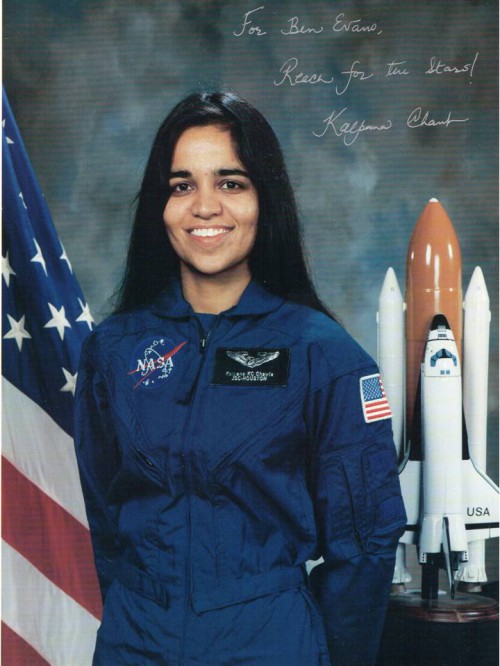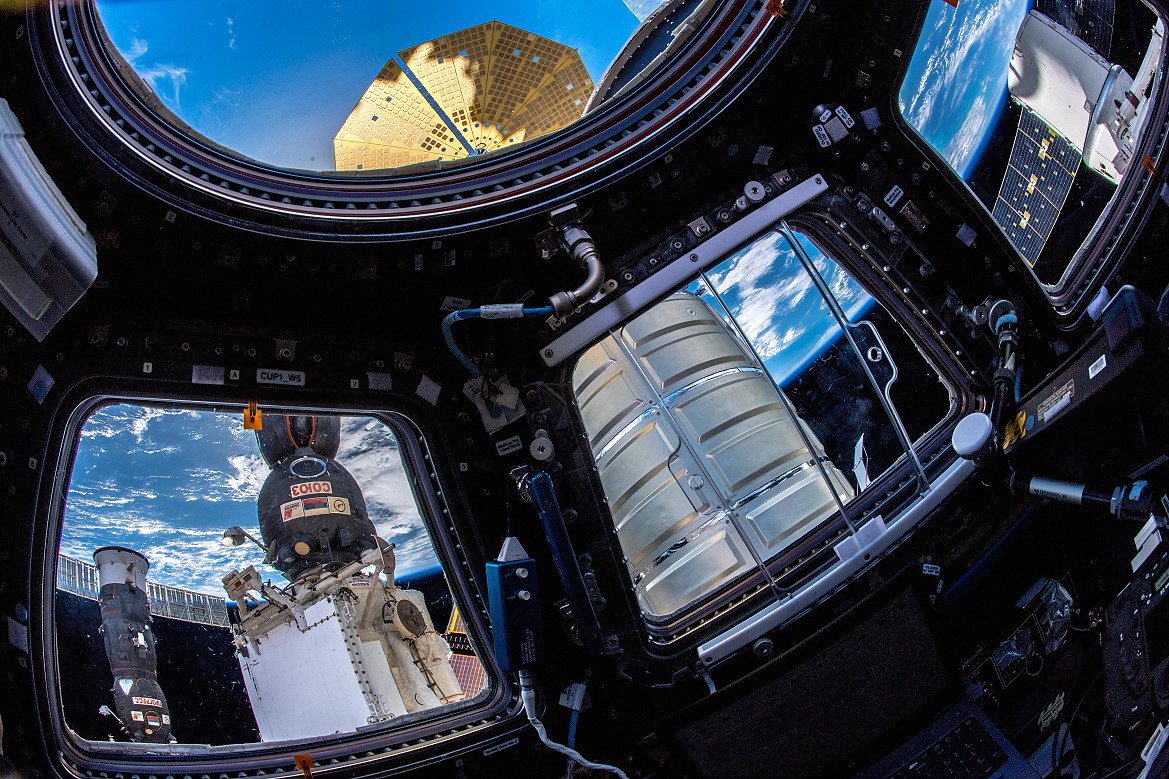7.10.2020

Four spacecraft are safely moored at the International Space Station (ISS) today, as Northrop Grumman Corp.’s NG-14 Cygnus supply ship—named in honor of STS-107 astronaut Kalpana “K.C.” Chawla—was robotically captured and berthed at the Earth-facing (or “nadir”) port of the Unity node. In addition to Cygnus, the station now also plays host to a pair of Russian Progress cargo vehicles and Soyuz MS-16, which brought Expedition 63 Commander Chris Cassidy and Flight Engineers Anatoli Ivanishin and Ivan Vagner uphill in April.
The Cygnus was launched last Friday night atop an Antares 230+ booster from Pad 0A at the Mid-Atlantic Regional Spaceport (MARS) on Wallops Island, Va., laden with 7,758 pounds (3,519 kg) of equipment, payloads and supplies for the incumbent Expedition 63 and forthcoming Expedition 64 crews.
Following its 9:16 p.m. EDT launch Friday and safe insertion into low-Earth orbit, the NG-14 Cygnus quickly settled into autonomous operations, deploying its fan-like UltraFlex solar arrays and commencing a 2.5-day chasedown of the sprawling multi-national orbiting outpost. In the small hours of Monday morning, with Cassidy at the controls of the 57.7-foot-long (17.6-meter) Canadarm2, backed up by Vagner, Cygnus appeared in the cross-hairs as a steadily brightening star. Views of the cargo ship at orbital sunrise were truly spectacular, as the surface of the Pressurized Cargo Module (PCM) appeared to turn from silver to bright white and the UltraFlex arrays glowed a brilliant gold.
Flying with rock-solid perfection, the NG-14 Cygnus reached its first “Hold Point” at a distance of 820 feet (250 meters) from the station. Shortly afterwards, unanimous approval was granted for the spacecraft to proceed within the so-called “Keep Out Sphere” (KOS). This virtual exclusion zone extends about 660 feet (200 meters) around the vicinity of the ISS to avert any risk of collision. Passing through the second Hold Point at 100 feet (30 meters), Cygnus moved towards its Capture Point, a mere 30 feet (10 meters) from the robotic clutches of Canadarm2. With Cassidy at the controls of the arm, and Vagner backing him up, the pair were given a definitive “Go for Capture”.
By this stage, the cargo ship had entered free drift, with all thruster disabled to ensure that no disturbances would be imparted on either vehicle. Meanwhile, the ISS itself entered a strict phase of “Attitude Hold”, reliant upon its suite of Control Moment Gyroscopes (CMGs). “Vehicle capture is where ISS motion control really shines,” AmericaSpace was told in previous comments by ISS Flight Controller Ben Honey. “It’s not so much a vehicle as a stable stationary platform, from which to joystick the arm in.”
From his perch inside the multi-windowed cupola, Cassidy extended the robotic arm to grapple Cygnus. He positioned the Latching End Effector (LEE) over the cargo ship’s grapple pin, thereby setting the final pieces in place for a perfect capture at 5:32 a.m. EDT, as the station and Cygnus flew 261 miles (420 km) above Egypt.
“Houston, Station, Cygnus capture is complete,” radioed Cassidy. “Go for Cygnus post-capture reconfiguration.”
Then he paused for a moment. Although two honorees from Columbia’s tragic final crew have now flown to the ISS aboard Cygnus missions, the person of Chawla—an accomplished aerospace engineer, astronaut and the first woman of Indian descent to voyage into space—is particularly poignant. Having flown a troubled mission on STS-87 in the fall of 1997, she went on to serve as flight engineer on STS-107, which ended on 1 February 2003 with Columbia’s untimely destruction a mere 16 minutes before landing.

“In the name of space exploration, all have given some, some have given all,” Cassidy began. “So it’s an honor to welcome the good ship Kalpana Chawla—“K.C.”, as we knew her. Welcome aboard the International Space Station, K.C.”
“We are excited for her third honorable visit to space,” came the reply from Capcom Jeanette Epps in the Mission Control Center (MCC) at the Johnson Space Center (JSC) in Houston, Texas. “We welcome the SS Kalpana Chawla to the International Space Station.” Epps—recently assigned to her first space mission, after a long and frustrating wait—was part of a Mission Control team led by Flight Director Pooja Jesrani.

Over the course of the next two hours, robotics officers in Mission Control worked to maneuver the NG-14 Cygnus towards its installation point on the Earth-facing (or “nadir”) Common Berthing Mechanism (CBM) of the Unity node. The physical berthing of the cargo ship occurred in two phases, with the Expedition 63 crew overseeing “First Stage Capture”, where hooks from Unity’s nadir CBM extended and grabbed Cygnus to bring their respective CBMs into contact.
Next came “Second Stage Capture”, where a series of 16 bolts—four gangs of four bolts apiece—were driven to rigidize them in a tight mechanized embrace. At length, Capcom Norishige Kanai confirmed that Cygnus was now formally a part of the space station at 8:01 a.m. EDT, as the complex sailed high over the South Pacific.
As previously outlined by AmericaSpace, the NG-14 mission will remain a part of the ISS until 16 December, when it will depart for two weeks of autonomous flight and a destructive re-entry in the atmosphere on the 30th. The cargo ship has brought 7,758 pounds (3,519 kg) of equipment, payloads and supplies to the station, including a new toilet, an experiment to grow radish plants and a night repair serum flying as part of a commercial partnership with Estée Lauder. Also aboard and destined to complete their missions during the post-unberthing autonomous free flight in December are Northrop Grumman’s SharkSat technology demonstrator and the fifth incarnation of the Spacecraft Fire Experiment (SAFFIRE-V).
Today’s safe arrival of the NG-14 Cygnus kicks off a busy month of October, which will next see U.S. astronaut Kate Rubins and her Russian crewmates Sergei Ryzhikov and Sergei Kud-Sverchkov launch from Baikonur Cosmodrome in Kazakhstan aboard Soyuz MS-17 on 14 October. Ryzhikov will assume command of the station to begin Expedition 64, with Cassidy, Ivanishin and Vagner currently targeted to return to Earth late on the 21st, wrapping up 195 days in orbit. Ten days later, in the wee hours of Halloween morning, a SpaceX Crew Dragon will launch Crew-1 astronauts Mike Hopkins, Victor Glover, Shannon Walker and Soichi Noguchi to expand the Expedition 64 increment to seven people.
Quelle: AS
